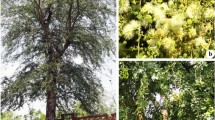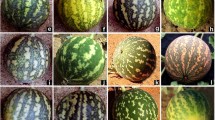Summary
Pinus radiata is the most important softwood plantation species in Australia and New Zealand. The improtance of this species in forestry has led to an increasing demand to improve the efficiency of selection time of the production population, which currently takes 13 yr by traditional methods. With the application of molecular biology techniques such as random amplified polymorphic DNA (RAPD) the selection period can be reduced to 6 yr. In this study, the conditions for RAPD were optimized and the feasibility of this marker system was investigated with different families ofPinus radiata from Tasmania and South Australia. Best concentrations of Taq-polymerase (1 U), magnesium chloride (2 mM), and template DNA (20 ng) were selected to test different polymerase chain reaction (PCR) thermocycler profiles. Devey's et al. (1996) program was the most effective for production of clear RAPD bands. Best conditions were investigated to screen 10–12 bp arbitrary Breasatec and Operon primers. Both types were found useful at detecting genetic variation between families. Seventy percent and thirty percent of the selected Bresatec and Operon primers, respectively, produced polymorphic bands.
Similar content being viewed by others
References
Carlson, J. E.; Tulsieram, L. K.; Glaubitz, J. C., et al. Segregation of random amplified DNA markers in F1 progeny of conifers.Theor. Appl. Genet. 83:194–200; 1991.
Devey, M. E.; Bell, J. C.; Smith, D. N., et al. A genetic linkage map forPinus radiata based on RFLP, RAPD, and microsatellite markers.Theor. Appl. Genet. 92:673–679; 1996.
Devey, M. E.; Delfino-Mix, A.; Kinloch, B. B., et al. Random amplified polymorphic DNA markers tightly linked to a gene for resistance to white pine blister rust in sugar pine.Proc. Natl. Acad. Sci. USA 92:2066–2070; 1995.
Erlich, H. A.; Kazarian, H. H., Jr.; Gibbs, R. A., Introduction—Polymerase chain reaction. Erlich, H. A.; Gibbs, R.; Kazarian, H. H., Jr., eds. Current communications in molecular biology. Plainview, NY: Cold Spring Harbor Laboratory Press; 1989:1–4.
Jobes, D. V.; Hurley, D. L.; Thien, L. B. Plant DNA isolation: method to efficiently remove polyphenolics, polysaccharides and RNA.Taxon 44:379–389; 1995.
Keller, G. H.; Manak, M. M. DNA probes, background, application, procedures. 2nd ed. Macmillan Publishers; 1993:1–288.
Landry, B. S. DNA mapping in plants. Glick, B. R.; Thompson, J. E., eds.Methods in plant molecular biology and biotechnology. London, England: CRC Press; 1993:269–283.
Lu, M. Z.; Szmidt, A. E.; Wang, X. R. Inheritance of RAPD fragments in haploid and diploid tissues ofPinus sylvestris (L.).Heredity 74:582–589; 1995.
Mosseler, A.; Egger, K. N.; Hughes, G. A. Low levels of genetic diversity in red pine confirmed by random amplified polymorphic DNA markers.Can. J. For. Res. 22:1332–1337; 1972.
Muralitharan, M. S.; Stuart, S.; Graham, M. (1994)Methods in Plant Molecular Biology Techniques. Proceedings of Molecular Biology Workshop. July 14–16, 1994, Launceston, Tasmania. Available from: Applied Biology, University of Tasmania; pp. 1–98), Launceston.
Neale, D. B.; Williams, C. G. Restriction fragment length polymorphism mapping in conifers and applications to forest genetics and tree improvement.Can. J. For. Res. 21:545–554; 1991.
Nelson, C. D.; Kubisiak, T. L.; Stine, M., et al. A genetic linkage map of longleaf pine (Pinus palustris Mill.) based on random amplified polymorphic DNAs.J. Hered. 85:433–439; 1994.
Nybom, H. DNA fingerprinting—a useful tool in fruit breeding.Euphytica 77:59–64; 1994.
Plomion, C.; Bahrman, N.; Durel, C. E., et al. Genomic mapping inPinus pinaster (maritime pine) using RAPD and protein markers.Heredity 74:661–668; 1994.
Plomion, C.; O'Malley, D. M.; Dure, C. E. Genomic analysis in maritime pine (Pinus pinaster): comparison of two RAPD maps using selfed and open-pollinated seeds of the same individual.Theor. Appl. Genet. 90:1028–1034; 1995.
Sambrook, J.; Fritsch, E. F.; Maniatis, T.Molecular cloning: a laboratory manual, Plainview, NY: Cold Spring Harbor Laboratory Press; 1989:5.3–6.6.
Smith, D. N.; Devey, M. E. Occurrence and inheritance of microsatellites inPinus radiata.Genome 37:977–983; 1994.
White, T.L. A conceptual framework for tree improvement programs.New For. 4:325–342; 1987.
Wilhelmina, T. G.; McNicol, R. The use of RAPD markers for the identification of Sitka spruce (Picea sitchensis) clones.Heredity 75:126–132; 1995.
Author information
Authors and Affiliations
Rights and permissions
About this article
Cite this article
Ostrowska, E., Muralitharan, M., Chandler, S. et al. Optimized conditions for rapd analysis inPinus radiata . In Vitro Cell.Dev.Biol.-Plant 34, 225–230 (1998). https://doi.org/10.1007/BF02822712
Received:
Accepted:
Issue Date:
DOI: https://doi.org/10.1007/BF02822712




